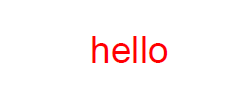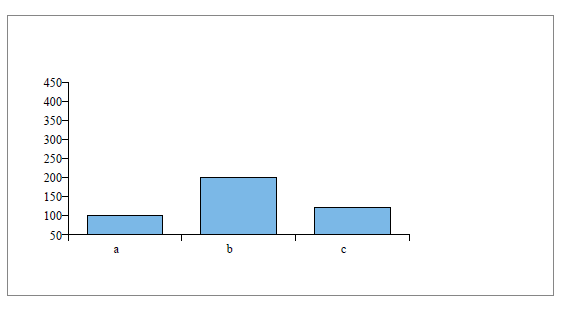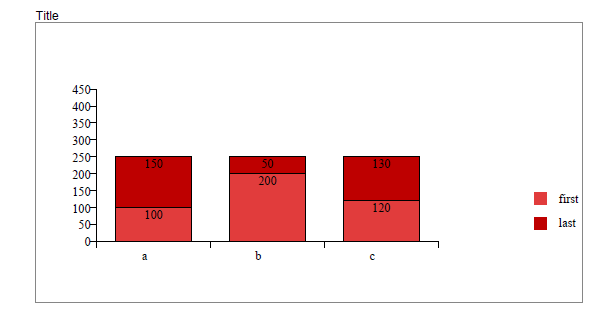python中的Reportlab模块详解最新推荐
reportlab模块是用python语言生成pdf文件的模块,安装方法也简单,这篇文章主要介绍了python中的Reportlab模块,需要的朋友可以参考下
python中的Reportlab模块
reportlab模块是用python语言生成pdf文件的模块
安装:pip install reportlab
模块默认不支持中文,如果使用中文需要注册
1.注册中文字体
下载自己需要的.ttf字体,例如STSONG.ttf
fromreportlab.pdfbaseimportpdfmetrics
fromreportlab.pdfbase.ttfontsimportTTFont
pdfmetrics.registerFont(TTFont('song', STSONG.ttf))
2.生成文字
from reportlab.lib.styles import getSampleStyleSheet
from reportlab.platypus import Paragraph,SimpleDocTemplate
from reportlab.lib import colors
Style=getSampleStyleSheet()
bt = Style['Normal'] #字体的样式
# bt.fontName='song' #使用的字体
bt.fontSize=14 #字号
bt.wordWrap = 'CJK' #该属性支持自动换行,'CJK'是中文模式换行,
用于英文中会截断单词造成阅读困难,可改为'Normal'
bt.firstLineIndent = 32 #该属性支持第一行开头空格
bt.leading = 20 #该属性是设置行距
ct=Style['Normal']
# ct.fontName='song'
ct.fontSize=12
ct.alignment=1 #居中
ct.textColor = colors.red
t = Paragraph('hello',bt)
pdf=SimpleDocTemplate('ppff.pdf')
pdf.multiBuild([t])
一份pdf文件可以定义多种字体样式,如bt和ct。字体有多种属性,这里只列举一些常用的属性,
其中,
wordWrap自动换行属性的参数'CJK'是按照中文方式换行(可以在字符之间换行),英文方式为'Normal'(在空格出换行)
alignment:0 左对齐
1 居中
2 右对齐
3.表格
from reportlab.platypus import Table
t = Table(data)
from reportlab.platypus import Paragraph, SimpleDocTemplate, Table,TableStyle
from reportlab.lib.units import inch
from reportlab.lib import colors
def table_model(data):
width = 7.2 # 总宽度
colWidths = (width / len(data[0])) * inch # 每列的宽度
dis_list = []
for x in data:
# dis_list.append(map(lambda i: Paragraph('%s' % i, cn), x))
dis_list.append(x)
style = [
# ('FONTNAME', (0, 0), (-1, -1), 'song'), # 字体
('FONTSIZE', (0, 0), (-1, 0), 15), # 字体大小
('BACKGROUND', (0, 0), (-1, 0), HexColor('#d5dae6')), # 设置第一行背景颜色
('BACKGROUND', (0, 1), (-1, 1), HexColor('#d5dae6')), # 设置第二行背景颜色
# 合并 ('SPAN',(第一个方格的左上角坐标),(第二个方格的左上角坐标)),
合并后的值为靠上一行的值,按照长方形合并
('SPAN',(0,0),(0,1)),
('SPAN',(1,0),(2,0)),
('SPAN',(3,0),(4,0)),
('SPAN',(5,0),(7,0)),
('ALIGN', (0, 0), (-1, -1), 'CENTER'), # 对齐
('VALIGN', (-1, 0), (-2, 0), 'MIDDLE'), # 对齐
('LINEBEFORE', (0, 0), (0, -1), 0.1, colors.grey), # 设置表格左边线颜色为灰色
,线宽为0.1
('TEXTCOLOR', (0, 0), (-1, 0), colors.royalblue), # 设置表格内文字颜色
('TEXTCOLOR', (0, -1), (-1, -1), colors.red), # 设置表格内文字颜色
('GRID', (0, 0), (-1, -1), 0.5, colors.grey), # 设置表格框线为grey色,线宽为0.5
]
component_table = Table(dis_list, colWidths=colWidths,style=style)
return component_table
Style=getSampleStyleSheet()
n = Style['Normal']
data = [[0,1,2,3,4,5,6,7],
[00,11,22,33,44,55,66,77],
[000,111,222,333,444,555,666,777],
[0000,1111, 2222, 3333, 4444, 5555, 6666, 7777],]
z = table_model(data)
pdf = MyDocTemplate('ppff.pdf')
pdf.multiBuild([Paragraph('Title',n),z])
4.添加边框
from reportlab.graphics.shapes import Drawing
d = Drawing()
参数有:
d.width:边框宽度
d.heigth:边框高度
d.background:边框颜色
等等。
边框中可使用add()添加文字,图形等内容
例:
在边框中添加文字
from reportlab.graphics.shapes import Drawing, Rect
from reportlab.graphics.charts.textlabels import Label
def autoLegender( title=''):
width = 448
height = 230
d = Drawing(width,height)
lab = Label()
lab.x = 220 #x和y是文字的位置坐标
lab.y = 210
lab.setText(title)
# lab.fontName = 'song' #增加对中文字体的支持
lab.fontSize = 20
d.add(lab)
d.background = Rect(0,0,width,height,strokeWidth=1,strokeColor="#868686",
fillColor=None) #边框颜色
return d
l = autoLegender('hello')
pdf=SimpleDocTemplate('ppff.pdf')
pdf.multiBuild([l])# **这种方法可以给边框中的图例添加颜色说明** def autoLegender(chart, categories=[], use_colors=[], title=''): width = 448 height = 230 d = Drawing(width,height) lab = Label() lab.x = 220 #x和y是title文字的位置坐标 lab.y = 210 lab.setText(title) # lab.fontName = 'song' #增加对中文字体的支持 lab.fontSize = 20 d.add(lab) d.background = Rect(0,0,width,height,strokeWidth=1,strokeColor="#868686",fillColor=None) #边框颜色 d.add(chart) #颜色图例说明等 leg = Legend() leg.x = 500 # 说明的x轴坐标 leg.y = 0 # 说明的y轴坐标 leg.boxAnchor = 'se' # leg.strokeWidth = 4 leg.strokeColor = None leg.subCols[1].align = 'right' leg.columnMaximum = 10 # 图例说明一列最多显示的个数 # leg.fontName = 'song' leg.alignment = 'right' leg.colorNamePairs = zip(use_colors, tuple (categories)) #增加颜色说明 d.add(leg) return d

5.饼状图
饼图需要添加在边框中
from reportlab.lib import colors
from reportlab.platypus import SimpleDocTemplate
from reportlab.graphics.shapes import Drawing, Rect
from reportlab.graphics.charts.textlabels import Label
from reportlab.graphics.charts.piecharts import Pie
def autoLegender( chart,title=''):
width = 448
height = 230
d = Drawing(width,height)
lab = Label()
lab.x = 220 #x和y是文字的位置坐标
lab.y = 210
lab.setText(title)
# lab.fontName = 'song' #增加对中文字体的支持
lab.fontSize = 20
d.add(lab)
d.background = Rect(0,0,width,height,strokeWidth=1,strokeColor="#868686",fillColor=None)
#边框颜色
d.add(chart)
return d
def draw_pie(data=[], labels=[], use_colors=[], width=360,):
'''更多属性请查询reportlab.graphics.charts.piecharts.WedgeProperties'''
pie = Pie()
pie.x = 60 # x,y饼图在框中的坐标
pie.y = 20
pie.slices.label_boxStrokeColor = colors.white #标签边框的颜色
pie.data = data # 饼图上的数据
pie.labels = labels # 数据的标签
pie.simpleLabels = 0 # 0 标签在标注线的右侧;1 在线上边
pie.sameRadii = 1 # 0 饼图是椭圆;1 饼图是圆形
pie.slices.strokeColor = colors.red # 圆饼的边界颜色
pie.strokeWidth=1 # 圆饼周围空白区域的宽度
pie.strokeColor= colors.white # 整体饼图边界的颜色
pie.slices.label_pointer_piePad = 10 # 圆饼和标签的距离
pie.slices.label_pointer_edgePad = 25 # 标签和外边框的距离
pie.width = width
pie.direction = 'clockwise'
pie.pointerLabelMode = 'LeftRight'
# for i in range(len(labels)):
# pie.slices[i].fontName = 'song' #设置中文
for i, col in enumerate(use_colors):
pie.slices[i].fillColor = col
return pie
data = [10,9,8,7,6,5,4,3,2,1]
labs = ['0000000','1111111','2222222','3333333','4444444',
'5555555','6666666','7777777','8888888','9999999']
color = [HexColor("#696969"),HexColor("#A9A9A9"),HexColor("#D8BFD8"),
HexColor("#DCDCDC"),HexColor('#E6E6FA'),HexColor("#B0C4DE"),
HexColor("#778899"),HexColor('#B0C4DE'),HexColor("#6495ED"),
HexColor("#483D8B")
]
z = autoLegender(draw_pie(data,labs,color),labs,color)
pdf=SimpleDocTemplate('ppff.pdf')
pdf.multiBuild([z])
6.柱状图
柱状图需要添加在边框中
from reportlab.graphics.charts.barcharts import VerticalBarChart
from reportlab.lib.colors import HexColor
def draw_bar_chart(min, max, x_list, data=[()], x_label_angle=0,
bar_color=HexColor("#7BB8E7"), height=125, width=280):
'''
:param min: 设置y轴的最小值
:param max: 设置y轴的最大值
:param x_list: x轴上的标签
:param data: y轴对应标签的值
:param x_label_angle: x轴上标签的倾斜角度
:param bar_color: 柱的颜色 可以是含有多种颜色的列表
:param height: 柱状图的高度
:param width: 柱状图的宽度
:return:
'''
bc = VerticalBarChart()
bc.x = 50 # x和y是柱状图在框中的坐标
bc.y = 50
bc.height = height # 柱状图的高度
bc.width = width # 柱状图的宽度
bc.data = data
for j in xrange(len(x_list)):
setattr(bc.bars[j], 'fillColor', bar_color)
# bar_color若含有多种颜色在这里分配bar_color[j]
# 调整step
minv = min * 0.5
maxv = max * 1.5
maxAxis = int(height/10)
# 向上取整
minStep = int((maxv-minv+maxAxis-1)/maxAxis)
bc.valueAxis.valueMin = min * 0.5 #设置y轴的最小值
bc.valueAxis.valueMax = max * 1.5 #设置y轴的最大值
bc.valueAxis.valueStep = (max-min)/4 #设置y轴的最小度量单位
if bc.valueAxis.valueStep < minStep:
bc.valueAxis.valueStep = minStep
if bc.valueAxis.valueStep == 0:
bc.valueAxis.valueStep = 1
bc.categoryAxis.labels.boxAnchor = 'ne' # x轴下方标签坐标的开口方向
bc.categoryAxis.labels.dx = -5 # x和y是x轴下方的标签距离x轴远近的坐标
bc.categoryAxis.labels.dy = -5
bc.categoryAxis.labels.angle = x_label_angle # x轴上描述文字的倾斜角度
# bc.categoryAxis.labels.fontName = 'song'
x_real_list = []
if len(x_list) > 10:
for i in range(len(x_list)):
tmp = '' if i%5 != 0 else x_list[i]
x_real_list.append(tmp)
else:
x_real_list = x_list
bc.categoryAxis.categoryNames = x_real_list
return bc
z = autoLegender(draw_bar_chart(100, 300, ['a', 'b', 'c'], [(100, 200, 120)]))
pdf=SimpleDocTemplate('ppff.pdf')
pdf.multiBuild([z])
6.累加柱状图
def draw_2bar_chart(min, max, x_list, data=[()],array=[()], x_label_angle=0,bar_color=[],
height=125, width=280):
'''
:param min: 设置y轴的最小值
:param max: 设置y轴的最大值
:param x_list: x轴上的标签
:param data: y轴对应标签的值
:param x_label_angle: x轴上标签的倾斜角度
:param bar_color: 柱的颜色 可以是含有多种颜色的列表
:param height: 柱状图的高度
:param width: 柱状图的宽度
:return:
'''
bc = VerticalBarChart()
bc.x = 50 # x和y是柱状图在框中的坐标
bc.y = 50
bc.height = height # 柱状图的高度
bc.width = width # 柱状图的宽度
bc.data = data
# 图形柱上标注文字
bc.barLabels.nudge = -5 # 文字在图形柱的上下位置
bc.barLabelArray = array # 要添加的文字
bc.barLabelFormat = 'values'
for j in xrange(len(data)):
setattr(bc.bars[j], 'fillColor', bar_color[j])
# bar_color若含有多种颜色在这里分配bar_color[j]
# 调整step
# minv = min * 0.5
minv = 0
maxv = max * 1.5
maxAxis = int(height/10)
# 向上取整
minStep = int((maxv-minv+maxAxis-1)/maxAxis)
bc.valueAxis.valueMin =0 #设置y轴的最小值
bc.valueAxis.valueMax = max * 1.5 #设置y轴的最大值
bc.valueAxis.valueStep = (max-min)/4 #设置y轴的最小度量单位
if bc.valueAxis.valueStep < minStep:
bc.valueAxis.valueStep = minStep
if bc.valueAxis.valueStep == 0:
bc.valueAxis.valueStep = 1
bc.categoryAxis.labels.boxAnchor = 'ne' # x轴下方标签坐标的开口方向
bc.categoryAxis.labels.dx = -5 # x和y是x轴下方的标签距离x轴远近的坐标
bc.categoryAxis.labels.dy = -5
bc.categoryAxis.labels.angle = x_label_angle # x轴上描述文字的倾斜角度
# bc.categoryAxis.labels.fontName = 'song'
bc.categoryAxis.style = 'stacked'
x_real_list = []
if len(x_list) > 10:
for i in range(len(x_list)):
tmp = '' if i%5 != 0 else x_list[i]
x_real_list.append(tmp)
else:
x_real_list = x_list
bc.categoryAxis.categoryNames = x_real_list
return bc
# 制柱状图
Style=getSampleStyleSheet()
n = Style['Normal']
my_color = [HexColor('#E13C3C'),HexColor('#BE0000')]
z = autoLegender(draw_2bar_chart(100, 300, ['a', 'b', 'c'],
[(100, 200, 120),(150, 50, 130)],
bar_color=my_color,
array=[['100','200','120'],['150','50','130']] ),
categories=['first','last'],
use_colors=my_color
)
pdf = MyDocTemplate('ppff.pdf')
pdf.multiBuild([Paragraph('Title',n),z])
7.添加页眉
添加页眉需要我们自定义模版
from reportlab.platypus.doctemplate import BaseDocTemplate, Frame
from reportlab.lib.units import cm
from reportlab.platypus import PageTemplate
from reportlab.lib.styles import getSampleStyleSheet
import os
def myMainPageFrame(canvas, doc): # 全局应用
"The page frame used for all PDF documents."
canvas.saveState()
canvas.setFont('Times-Roman', 12)
pageNumber = canvas.getPageNumber()
if pageNumber > 0:
pic_yemei = os.path.join(os.path.dirname(__file__),'yemei01.jpg') # 页眉图片
pic_line_file = os.path.join(os.path.dirname(__file__),'line.jpg') # 页眉线
canvas.drawImage(pic_yemei, 75, 795, width=100,height=25)
canvas.drawImage(pic_line_file, 75, 780, width=450, height=15)
canvas.drawString(10*cm, cm, str(pageNumber))
canvas.restoreState()
class MyDocTemplate(BaseDocTemplate): # 自定义模版类
"The document template used for all PDF documents."
_invalidInitArgs = ('pageTemplates',)
def __init__(self, filename, **kw):
frame1 = Frame(2.5*cm, 2.5*cm, 15*cm, 25*cm, id='F1')
self.allowSplitting = 0
BaseDocTemplate.__init__(self, filename, **kw)
template = PageTemplate('normal', [frame1], myMainPageFrame)
self.addPageTemplates(template) # 绑定全局应用
Style=getSampleStyleSheet()
n = Style['Normal']
z = autoLegender(draw_bar_chart(100, 300, ['a', 'b', 'c'], [(100, 200, 120)]))
pdf = MyDocTemplate('ppff.pdf')
pdf.multiBuild([Paragraph('Title',n),z])到此这篇关于python中的Reportlab模块的文章就介绍到这了
相关推荐
PHP实现部分字符隐藏
 沙雕mars · 1325浏览 · 2019-04-28 09:47:56
沙雕mars · 1325浏览 · 2019-04-28 09:47:56
Java中ArrayList和LinkedList区别
 kenrry1992 · 908浏览 · 2019-05-08 21:14:54
kenrry1992 · 908浏览 · 2019-05-08 21:14:54
5月语言排行榜:R 跌出前二十,Python 紧咬 C++
 manongba · 688浏览 · 2019-05-09 17:27:24
manongba · 688浏览 · 2019-05-09 17:27:24
Tomcat 下载及安装配置
 manongba · 970浏览 · 2019-05-13 21:03:56
manongba · 970浏览 · 2019-05-13 21:03:56
什么是SpringBoot
 iamitnan · 1086浏览 · 2019-05-14 22:20:36
iamitnan · 1086浏览 · 2019-05-14 22:20:36
分类专栏
最新发布
最热排行




0评论